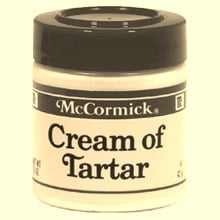 Tartrate Crystals [Tar-trate]
Tartrate Crystals [Tar-trate]
I’ve worked in restaurants my whole life and have encountered tartrates quite a bit.
Before a wine is bottled to be sold, wineries usually employ a procedure called cold stabilization (which brings the wine down to a near freezing temperature) in order to remove these “wine diamonds” as they’re sometimes more fondly called. It’s worth noting that Potassium Bitartrate (to give tartrates their full name) is a natural byproduct of the fermentation process.
After the tartrates are removed, the winery can then go on to sell them to the baking industry as Cream of Tartar. Winemaking is the only known source of Cream of Tartar.
The main problem is that consumers in the U.S. are used to seeing clear, pure, filtered white wines with no particles, and so the presence of crystals can sometimes create panic in the streets! Maybe a slight exaggeration, but I know there must be a good amount of wine needlessly wasted each year due to “wine diamonds”. I’ve even heard of wine distributors refusing to carry certain wines due to the presence of tartrates.
In Europe, tartrates in a bottle of wine tend to be more common-place and even encouraged, due to their presence being an indicator of a more naturally made wine.
How to tell if your wine is affected
Tartrate crystals unfortunately can resemble tiny shards of glass, but more often just resemble salt granules, and are usually quite noticeable in white wines. You’ll also sometimes see them on the underside of a cork.
Your course of action
Let the wine warm up for a few minutes, normally they will just disappear into the wine. Don’t go to the trouble of sending the wine back. Normally tartrates sink to the bottom of the bottle, so just pour it slowly, the same as you would if your bottle has sediment.
Click here for the rest of my —-> A Guide to Wine Faults posts.


Deadocmike
Or you could add some pickle relish and mayonnaise and have wine flavored tartar sauce.
Kris Chislett
I like where your head’s at!
Gjvnapa
Wine Crystals: Wine Diamonds
On occasion, when a bottle of wine
is opened, you will notice a crystalline deposit that looks like a cluster of
coarse salt at the bottom of the bottle or possibly glistening at the end of
the cork. The clear diamond-like crystals found in wine are potassium
bitartrate in crystalline form. This is basically the same stuff as the cream
of tartar in your kitchen pantry.
The principal acids found in
grapes, and hence wine, are tartaric and malic acids. These acids are produced by
the grape as it develops. Potassium also exists naturally in grapes. When the
wine is under chilly conditions, the tartaric acid and potassium bind together.
The marriage produces potassium bitartrate (KHT) crystals: wine diamonds. They
are completely harmless and quite natural. In Europe
these wine diamonds are accepted as a sign that the wine is a natural one. To
many these diamonds are even appreciated. Americans, however, are used to wine
being without the crystals.
The winery, in order to fulfill the
consumers’ expectations, forces a pre-crystallization at the winery. This
process is called “cold stabilization”. It beats the crap out of the wine! The
wine is chilled to just above freezing; generally 21º to 23º F. It is
held at this temperature for about two weeks. During that time, the KHT is
formed in the wine. In order to remove all the KHT, the wine is filtered at
this cold temperature. The KHT, and host of other things, are removed from the
wine at this cold temperature. During this handling, the wine also becomes
saturated with oxygen. That’s a no-no. After the cold filtration, the wine is
then run through a heat exchanger to bring it up to cellar temperature. But the
wine must now be sparged with nitrogen gas to remove the oxygen, and again, a few
other aromatic compounds. Any winemaker who has ever tasted any wine before and
after “cold stabilization” wants to cry. If the winemaker is patient, this same
removal of KHT will occur over a longer period of time at cellar temperature.
Most red wines left in barrels for 12 months or more are not subjected to this
abuse. Some wineries do not want any of their wines to become “cold stabilized”
in a hurried fashion. Bravo!
So, let’s marvel at these little
wine diamonds. If you’re lucky to find them, raise your glass and enjoy the
wine with the assurance that this wine has been handled as naturally and gently
as possible and allowed to attain the highest quality.
28
October 2004 George
Vierra WineCrystals
Mike
Gjvnapa, if that’s how you cold stabilize your wine, I can see why you would be crying at the end. The process is just simply not that brutal. You pre-seed the wine with potassium bitartrate, chill to just under 40F (not sure where you get this 21 to 23), keep it chilled for two weeks maximum (usually one week), then let it come to temperature on its own. Heat exchanger? Please. Hot water over the top of the tank does the same thing without pumps. If your filtration is done correctly, very litle else is removed and with almost zero oxygen pickup. So no additional sparging necessary. If our cellar crew ‘beat up’ our wine during this process to the extreme as you described, they would be fired for thier incompetence. I don’t know how wineries did it 50 years ago, but this is 2012. There is no excuse for massive flavor changes to blends because of cellar practices.
Kris Chislett
Great insight, Mike. Thanks for taking the time! It’s quite refreshing to see both sides of the story on this issue.